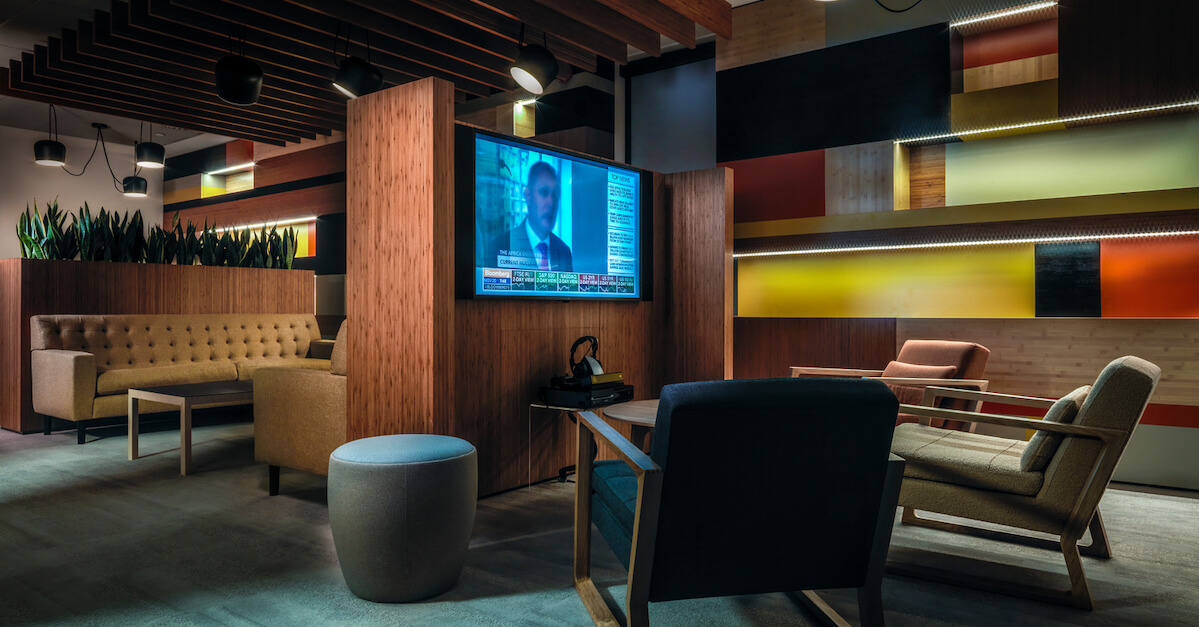
What is a Huddle Room?
As Millennials started replacing Boomers, they brought with them the idea of open office environments. And, while these open spaces created an aesthetic the new professionals desired, it also shined a bright light on the dire need for meeting room configurations that would enable small teams to collaborate without disruption.
Unfortunately, these small, convenient meeting spaces are not as prevalent in today’s office configurations. As such, 40% of employees say that they waste half an hour per day looking for meeting spaces. Obviously, it does not take long for those half hour blocks of wasted time to add up to days or even weeks of totally unproductive man-hours.
.jpg?width=1200&name=ELC999_N18_medium%20(1).jpg)
Fortunately, this is where the huddle room shines. Unlike a conference room or boardroom, huddle rooms are often intentionally designed to accommodate between two and five people. Which, in reality, meets the need for the vast majority of meetings in today’s digital world. According to a survey by the architecture and design firm HOK, 73 percent of meetings involve only two to four people, but 53 percent of conference-room space is built for meetings of seven or more.
.jpg?width=1200&name=Huddle_Space_Huddle_3_(_Red_).jpg)
As we discussed in a previous post, there are a number of key components that define an effective and productive huddle space. Specifically, huddle rooms are:
Comfortable and convenient
This including comfortable furnishings, proper lighting, quiet and located in various spots throughout the office. Fortunately, since huddle rooms only accommodate a few people most offices can easily allocate space for multiple rooms.
Furnishings should take into account the type of work for which your employees will most commonly utilize the space. Is a table with movable chairs more important than comfortable seating? Depends on the intended use.
.jpg?width=1197&name=bartosz-kwitkowski-aEo8SQ2hTZY-unsplash%20(1).jpg)
Productive and functional
Simply put, huddle rooms are only meaningful when they have the tools and technology team members need in order to have effective meetings with their coworkers or strategic partners. The appropriate deployment of audiovisual equipment (high definition monitors, projectors, etc.) can make a significant difference.
The key here is to focus heavily on what actually empowers your team to stay productive. For instance, if an office environment includes a number of marketing and engineering professionals, having smartboards, mini-video walls or even video cameras to capture brainstorming sessions could prove instrumental.
.jpg?width=1200&name=Huddle_Space_Huddle_1_(_City_).jpg)
Capable of reaching beyond its walls
Just because a huddle space only fits a few people should not limit team members from bringing others into the conversation and collaboration session. As such, equipping a huddle room with video conferencing capabilities means team members can quickly add someone from finance and legal into the discussion.
According to Frost, the need to include video conferencing within huddle rooms is not just significant with as more team members capitalize on remote work opportunities – the need is growing. Although only 8.1 percent of huddle room meeting currently leverage video conferencing, Frost anticipates that huddle-room meetings will grow exponentially to represent almost 70 percent of all video conferencing meetings by 2022.

While often simple, properly designed huddle rooms are a key component to transform a smart office into a highly productive environment that encourages collaboration.
Need help building your huddle room? With 55+ years of experience designing and deployment spaces that deliver smart and immersive experiences, Electrosonic has the expertise you need to get it right. Click here to learn more.
Victoria Cosgrave
Victoria Cosgrave, Field Marketing Manager, Enterprise at Electrosonic, has wide-ranging experience of technology within professional services, financial services, infrastructure, transport, pharmaceuticals and government. Her knowledge and experience enables her to write about the technological landscape and the issues facing clients with great insight.










.jpg?width=1500&height=995&name=ELC501_N17_medium%20(1).jpg)







































































































































































































